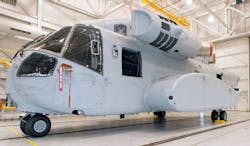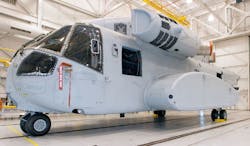Sikorsky to test first CH-53K prototype heavy-lift helicopter and associated avionics
WEST PALM BEACH, Fla., 5 Dec. 2012. Engineers developing the Sikorsky CH-53Kheavy-lift helicopter for the U.S. Marine Corps delivered the Ground Test Vehicle (GTV), the very first prototype aircraft off the assembly line, to the flight test team.
Sikorsky, a subsidiary of United Technologies Corp. (NYSE:UTX), will perform hundreds of hours of powered ground checks to test the GTV aircraft; four follow-on flight test helicopters will take to the skies between 2014 and 2015.
Sikorsky engineers are designing, building, and testing the GTV and the four Engineering Development Models as part of a $3.5 billion System Development and Demonstration contract. Flight test engineers will perform preliminary acceptance tests that include calibrating the GTV's fuel system and attaching measuring devices at more than 1,300 test locations on the aircraft to record temperature, aerodynamic loads, pressure, and vibrations.
These test will thoroughly test and measure the performance of the CH-53K helicopter's dynamic systems, including the rotor blades, transmission, and engines, while the aircraft is tied to the ground, explains Sikorsky CH-53K Program Vice President Michael Torok. "Extensive ground-based flight checks with Sikorsky and NAVAIR test pilots at the cockpit controls will confirm whether these dynamic systems, as well as hydraulic, electrical, and avionics systems, can meet the requirements established by the Marines for their next-generation heavy-lift helicopter."
CH-53K helicopters will begin to replace CH-53E Super Stallion helicopters in 2019, tripling the external load carrying capacity to more than 27,000 pounds over 110 nautical miles under "high hot" ambient conditions. Increased lift is enabled by: 7,500-shaft-horsepower GE38-1B engines; a split torque transmission design that more efficiently distributes engine power to the main rotors; fourth-generation composite rotor blades for enhanced lift; and a composite airframe structure.
"This is an important point of transition for the CH-53K program," says Col. Robert Pridgen, program manager for the heavy-lift helicopters. "I am encouraged by the initial results of our testing at the component and subsystem level. Now we bring it all together. The GTV is our first dynamic system-level integration of those same components. We are looking forward to the sights and sounds these next heavy lifters will bring to the Marine Corps."
Two additional ground test articles are undergoing airframe structural testing at Sikorsky's main manufacturing plant in Stratford, Conn., as part of the same contract.
The aircraft's major fuselage sections are supplied by Aurora Flight Sciences, ITT Exelis, GKN Aerospace, and Spirit Aerosystems.
The prototype assembly line is located at Sikorsky's Florida Assembly and Flight Operations facility inWest Palm Beach. Ground and flight testing will occur at the Developmental Flight Center on the same Florida campus.
Follow Avionics Intelligence news updates on Twitter (@Avionics_Intel), LinkedIn, and Google+.

